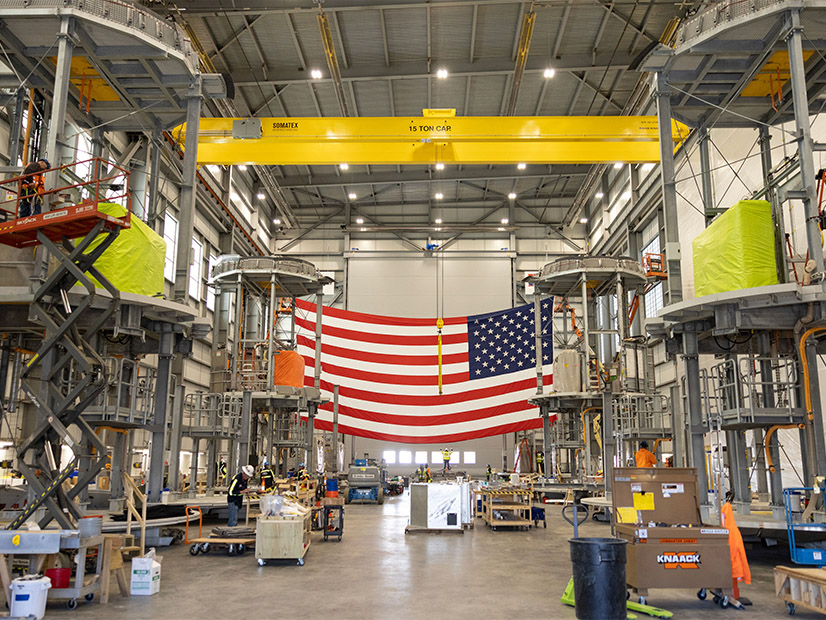
Revolution Wind on Tuesday became the fourth utility-scale U.S. offshore wind project to gain federal approval.
At full capacity, the facility south of the Rhode Island and Massachusetts coast will send 704 MW of power to Connecticut and Rhode Island.
Fabrication of components began this year. Developer Ørsted said in a news release Tuesday that the project remains on track for onshore construction activities to begin in coming weeks and for offshore construction to begin in earnest in 2024. It is targeting a 2025 operational date.
The record of decision issued Tuesday by the Bureau of Ocean Energy Management signals BOEM’s approval of the construction and operations plan.
The decision is being presented by the Department of Interior and the Biden administration as the green light for the project, but BOEM still must issue final approval of the plan. Additional state and federal authorizations are needed as well.
Ørsted said it anticipates receiving BOEM’s approval in November.
Tuesday’s announcement came just shy of 10 years after BOEM executed wind energy lease OCS-A 0486 with an entity called Deepwater Wind New England LLC.
It was later divided into two areas: South Fork Wind and Revolution Wind.
Among the cluster of wind energy areas being developed off the eastern tip of Long Island and the southeastern corner of New England, Revolution Wind will be one of the closest projects to land.
The plan approved by BOEM is a modified version that reduces the number of turbines erected in an attempt to reduce its visual profile and limit the impact on people and industries that use the ocean, such as fishers.
Revolution Wind has committed to compensate recreational and commercial fisheries for losses directly arising from the project.
Details
Revolution Wind is a joint venture of industry leader Ørsted and New England utility Eversource, which is looking to exit the partnership and exit offshore wind development all together.
In a news release Tuesday, the pair touted the economic impact Revolution Wind already has had, even before gaining approval, including: investment of $100 million to help redevelop the State Pier in New London, Conn.; creation of a regional offshore wind component fabrication facility in ProvPort, R.I.; commissioning five vessels at local shipyards; and contributions to multiple career-development programs.
BOEM’s parent agency, the Department of the Interior, said construction of Revolution Wind is expected to create about 1,200 local jobs.
Some of the new shoreline infrastructure already is in use as Ørsted and Eversource build the 132 MW South Fork Wind, which is expected to begin commercial operations before the end of this year.
South Fork gained a critical advantage by being in the forefront of U.S. offshore wind development.
Other projects that are not as far along in the yearslong planning-review-permitting process have been clobbered by soaring material costs and interest rates in the past two years.
Ørsted and Eversource have told New York state they need more money to proceed with Sunrise Wind 1, for example.
New York, in turn, invited them to rebid Sunrise 2 into the most recent solicitation at a lower cost, before the state makes final contract decisions.
The two partners also saw their 884 MW Revolution Wind 2 proposal rejected as too expensive in Rhode Island.
And Ørsted sought and received more money from New Jersey for Ocean Wind 1, a project it is pursuing solo. It became the third offshore wind plan greenlighted by BOEM, last month.
Other developers are citing the same problems with their projects along the Northeast coast, suggesting the first major buildout of offshore wind in the Americas will be slower and/or more expensive for ratepayers than initially projected.
Commentary
Tuesday’s decision was hailed as a milestone and landmark.
Offshore wind has been a priority for President Biden, who has set a goal of 30 GW by 2030. BOEM said in a news release that Tuesday’s approval of Revolution Wind puts the agency on track to complete review of 16 projects with more than 27 GW of nameplate capacity by 2025.
“Today’s approval is not the end of our work on this project. We will continue to maintain open communication and frequent collaboration with federal partners, tribal nations, states, industry and ocean users to address potential challenges to and identify opportunities for the continued success of the U.S. offshore wind industry,” said U.S. Interior Secretary Deb Haaland.
“As the first offshore wind project solicited by Connecticut, we are particularly pleased to see Revolution Wind receive final approval from BOEM, clearing the way for the project to fulfill its promise of delivering clean energy, providing good jobs and enhancing local economies,” said Charles Rothenberger of New England for Offshore Wind.
“The U.S. offshore wind industry is on the move,” said Liz Burdock, CEO of the Business Network for Offshore Wind. “The steady stream of offshore wind project environmental reviews is critical to the success of supply chain investments, and today’s announcement bolsters investments in component production at ProvPort in Rhode Island, cable manufacturing in South Carolina, steel fabrication in western New York, and shipbuilding in Texas and Louisiana.”
“The Revolution Wind project will play a significant role in advancing the state’s Act on Climate law, growing our clean energy economy and achieving our 100% renewable energy standard objectives,” said Rhode Island Gov. Dan McKee.
“With the federal record of decision, we now advance Revolution Wind to the construction phase, bringing good-paying jobs to hundreds of local union construction workers, keeping local ports busy with assembly and marshaling activities and further growing the local supply chain,” said David Hardy, CEO Americas at Ørsted.
“The extreme weather we’ve experienced this summer underscores the growing dangers and devastating effects of global warming, as well as the need for bold solutions to address the climate crisis,” said Connecticut Gov. Ned Lamont (D).



